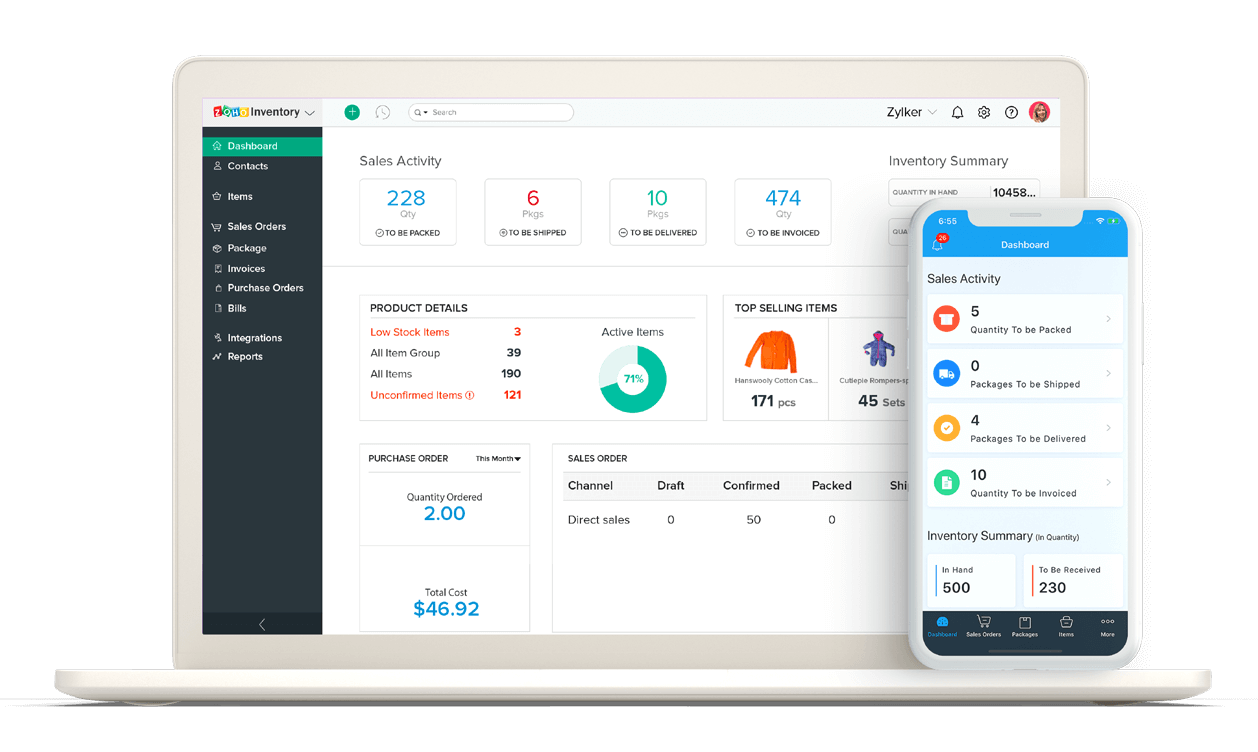Automation in warehousing
Automation plays a vital role in all aspects of a business, but especially in the most complex tasks. Many of these tasks are carried out in a warehouse, which acts as the center of the daily inventory management operations of a company. Implementing modern technology in a warehouse can help any business to automate these tasks, improve profitability, and stay competitive.
However, there’s a wide array of technologies to choose from, so business owners need to find those technologies that improve efficiency, streamline operations, reduce costs, and ensure that goods and materials flow effortlessly.
Let us look at types of automation and some of the most common technologies used to automate warehouse tasks.
Types of automation
There are two types of automation:
- process automation
- physical automation
Process automation is about gathering information and moving it around. It automates the daily tasks of collecting information and centralizing it so that it can be easily accessed by everyone. For example, the data entered by a staff member while picking an item can be stored in a common database along with information related to the item’s order and shipping details. If another worker needs to check whether the right item was sent, having the picking data at hand makes the process more reliable and less time-consuming.
Physical automation, on the other hand, is about moving physical objects. It uses a range of simple and complex robots to reduce the amount of time that warehouse staff spend picking up and carrying items, allowing faster and more consistent picking and packing. Now let’s get into the details and find out how these types of automation have an impact at different levels within an organization.
Process automation
Process automation can be further divided into,
- Inventory management software
- Smart warehouse apps
- Data collection and analysis
Inventory management software
Inventory management software allows you to track goods across the business' entire order cycle, from keeping a count of stock in the warehouse to manage orders and deliver them to the customer. Here’s how inventory management software uses process automation to make warehousing more efficient.
-
Barcode scanning: Barcode scanning is used to identify and track the items in your stock. Barcode scanners collect item information like SKU and manufacturer code, which can be used in other operations within the warehouse. For instance, by scanning serial and batch numbers, you can see the movement and expiration dates of your items. Barcode scanners also help to perform accurate shelf counts during stocktaking, and rapidly distinguish between analogous items.
-
Inventory optimization: Most inventory software offers grouping and bundling , which helps you to sort items based on common features, or create customized bundles of items that customers might want to purchase together.
-
Stock notifications: Inventory software can send automatic notifications when the stock level of a particular item is low, which is helpful because it helps you avoid over- or understocking. In the long run, this keeps your stock levels optimal, which helps your cash flow and keeps your customers happy.
-
Report generation: This feature allows warehouse owners to understand their sales, the demand for their items, and their profit margins. It also helps them to measure and evaluate their distribution center activities and stocking strategies, giving them a strong base for building future improvements.
-
Order tracking and supply chain management: Order management is an ongoing process, including creating an order, picking the items, packing, shipping, and delivery. With inventory software, all the data generated at each step can be accessed, viewed, and tracked in a single place. This means your entire supply chain can be monitored easily without switching between multiple apps.
Smart warehouse apps
The inside of your warehouse is a busy place, where there is always movement. Items in inventory are constantly received, putaway, rotated, and picked with the help of your warehouse staff. As a result, staff do a lot of manual data entry while they’re on the move. This can be slow and unreliable.
Apps can help here. Warehouse apps make data entry, item tracking, and inventory monitoring easier and faster. They can be installed on ordinary smartphones and even, in some cases, wearable technology.
Smartphones
Advancements in smartphone technology mean that a lot of work that was previously handled at big fixed workstations can now be managed by handheld devices. According to a report sponsored by Honeywell, 85% of warehouse managers are either using or planning to use smartphones in their warehouse.
An Inventory app allows users to track resources and stock using ordinary iOS or Android devices. These apps can supplement or even replace customary warehouse technology for barcode and QR code scanning and lookup. Also, you can track your stock in real-time with a stock tracking app
For example, using a smartphone camera to scan items can make stocktaking faster and more accurate. Instead of carrying a paper checklist and writing down shelf counts by hand, warehouse staff can just scan each item and the count automatically gets updated across all the systems in the warehouse. This cuts down on data entry as well as errors stemming from illegible handwriting and missing forms.
Wearable technology
Wearables—like smartwatches, smart glasses, augmented reality interfaces, and voice-enabled devices—are becoming very popular and providing new, creative ways to interact with information systems in a warehouse.
In a warehouse context, these devices offer a convenient way to access contextual information while moving around the warehouse. For instance, using smart glasses that show the system used to arrange the products can help warehouse workers better understand where each item should be. This can help them avoid making mistakes while putting away existing products and locate empty spaces more quickly when adding new ones. This will increase visibility, decrease error rates, create a better flow of information, and improve safety. All of this will increase the service levels and lower operating costs.
There are a number of advantages of a system based on mobile devices and apps:
-
It has a much lower implementation cost than a system based on specialized equipment, and is easier to use remotely.
-
It uses devices that the staff are probably already acquainted with, so they will only need to be trained on using the new apps, not the devices themselves.
-
These applications are centrally updated, so all the warehouse staff have access to the most recent inventory data and the most current app version, without anyone needing to manually program or update each device.
-
Mobile inventory apps store information in the cloud, guaranteeing higher security whether the data is being accessed remotely or locally.
Data collection and analysis
It would be not wrong to say that the data is at the center of all warehouse activities. It is needed to track the movement of items, report on business performance, analyze warehouse operations, and make decisions and predictions based on the analysis. However, in a large and complicated space like a warehouse, it is challenging to collect the data, collate it, and analyze it. It is not feasible to do all of this data management manually.
In this section, we will cover some of the most common ways that data collection is automated in warehouses.
Radio Frequency Identification Technology (RFID)
RFID is a system of tags and readers that can be used to automatically track items in the warehouse. RFID tags, which can be attached to products, contain at minimum a microchip and an antenna. They’re tracked by an RFID reader, which uses an electromagnetic field to recognize and read the tags. RFID technology is beneficial when it comes to the real-time tracking of products, giving warehouse owners greater stock visibility and transparency, making inventory counting easier, and reducing theft.
RFID tags can be either active or passive.
Active, or dynamic, RFID tags, have their own transmitter and power source located right in the tag. They are typically bigger and more costly than their passive counterparts and are used to track large resources like load holders, vehicles, and machines.
Passive RFID tags do not have their own power source. They get power from the receiver, which emits a radio frequency signal. This signal charges the RFID tag and sends back the tag’s information to the reader.
Passive tags are normally lighter, more affordable, and more adaptable than active tags. They can be used for many applications including access control, file tracking, and supply chain management.
Predictive analysis
Predictive analysis enables warehouse owners to interpret their data and use statistical techniques, such as predictive modeling, pattern recognition, and trend analysis to make informed guesses about future demand. This helps in optimizing inventory levels, increasing operational efficiency, anticipating stock needs (which in turn reduces restocking costs), and making efficient, end-to-end warehouse management possible.
IOT and blockchain
The transformation of warehouse management involves two basic processes: gathering real-time data and improving interconnectivity. Traditionally, data is collected through handwritten notes on paper or manually keyed in to stand-alone systems. This tends to result in slow data collection and a lack of connection between the different warehouse processes.
The Internet of Things (IoT) is essentially a collection of interconnected sensory devices that collect pieces of data such as location, humidity, and temperature. All of this data can be stored and monitored on a network in real time. In a warehouse, this can be used to monitor the storage conditions of delicate inventory items and make any needed adjustments quickly and automatically. For instance, if a warehouse stores medications that need to be kept below a certain temperature to avoid spoilage, an IoT-enabled system can detect if the storage room gets a little too warm and turn up the refrigeration before the medications start to spoil.
The network performing this monitoring can utilize blockchain, which is a system of digital ledgers that record transactions in a series of connected blocks. The data in these blocks lives inside every computer on the network and can be accessed anywhere across the network. It’s a model that is both decentralized and also distributed, which makes it nearly incorruptible. To hack the network, someone would have to access all the computers in the network simultaneously, which would be much more difficult than hacking an individual system. This creates a secure, transparent system capable of collecting reliable real-time data across the warehouse.
Physical automation
So far, we’ve focused on process automation and the movement of information. In contrast, physical or mechanized automation is about the movement of physical goods around the warehouse. It uses a range of simple and complex robots to reduce the amount of time that warehouse staff spend picking up and carrying items, allowing for faster and more consistent picking and packing. These robots include Automated Guided Vehicles (AGVs) and Autonomous Mobile Robots (AMRs).
Automated Guided Vehicles and Autonomous Mobile Robots
Automated Guided Vehicles are robots that follow a predetermined path for navigation inside the warehouse. They have revolutionized the transportation of goods both inside and outside the warehouse, because transporting inventory in an automated way is faster and safer for employees than driving forklifts. They have become more economical to use as AGV technology improves.
Autonomous Mobile Robots are essentially advanced versions of AGVs. They do not have to follow a specific route to navigate within the warehouse, but can actually detect what is around them. They’re usually equipped with sensors and cameras which help them to move around in the warehouse.
Here are some common kinds of equipment used for physical automation:
-
Automated Guided Carts: AGCs are one of the most basic types of AGVs and have minimal features. They have a very simple sensor system and usually follow strips of magnetic tape to navigate their environment. They are used to transport all sorts of materials and vary in size and weight.
-
Forklift AGVs: These transport pallets like a standard forklift, but without the need for a human operator.
-
Drones: These are one of the types of Autonomous Mobile Robots used in the warehouse, which are typically more technologically advanced than AGVs. Because they fly, they can reach even the innermost and the topmost pieces within a warehouse. If they’re equipped with the right sensing technology, like cameras, barcode scanners, and RFID readers, drones can do a complete inventory count in a fraction of the time it takes to do it manually.
-
Towing vehicles: These are mechanized vehicles equipped for pulling non-mechanized vehicles with loads behind them, similar to a train. Over the years this technology has become more advanced, and now includes towing vehicles that are laser-navigated.
-
Articulated robotic arms: This is a type of automation device that doesn’t move around the warehouse, but manipulates items within its own limited area. Robotic limbs with articulated joints, also known as pick-and-spot robots, can be used to move, turn, and lift things in the distribution center. They are normally utilized for picking, packing, and preparing for shipment.
A modern warehouse can include many types of essential technology, all contributing different kinds of improvement to the flow of warehouse operations. Some, like inventory management software, smart warehouse apps, and IoT networks, facilitate a better flow of information—which helps warehouse managers monitor their operations, predict future needs, and make smart business decisions. Others, like automated carts, drones, and robotic arms, physically move and manipulate the items in the warehouse. Together, they save time and money, reduce errors, and make warehouses more secure.







































